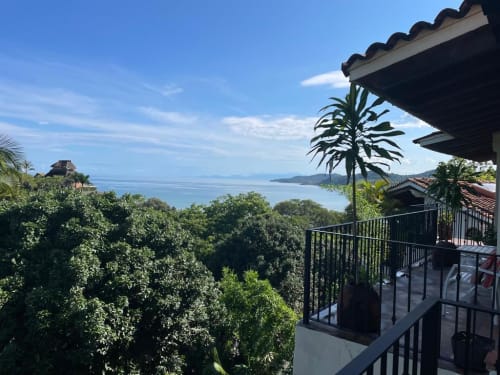SayulitaLife.com members can easily save favorites for vacation rentals, local businesses, real estate and more.
Sign In Create free accountList Your Property
A hidden paradise in Sayulita Mexico (Janelle Brown The New York Times)
A hidden paradise in Mexico---Janelle Brown The New York Times
But this quiet fishing village is slowly getting popular
The tiny fishing village of Sayulita, Mexico, just an hour's drive north of Puerto Vallarta, is still only a footnote in most travel guides. But to those visitors who have discovered its charms in recent years - the uncluttered white beaches, the tidy surf break, the amiable fishermen gutting their catch by the sea, the tranquil town square with its rustic taco stands and tortillerias - there's only one thing wrong with Sayulita.
.
It's beginning to get a little too popular. Sleepy Sayulita is in danger of becoming a hot spot, and the longtime winter residents and newcomers alike sit in their vacation homes, eyeing the construction taking place farther down the beach and worrying that the authentic local way of life will vanish if more people arrive.
.
"We know Sayulita is being discovered, and it's inevitable," said Janet Jamieson, a 57-year-old Oregonian and six-year resident who, with her husband, spends several months a year in Mexico. "Now you have espresso stands, Internet caf�s, a fancy galleria," she said. "And building, everywhere. We think of Puerto Vallarta, and just hope Sayulita can still retain its flavor of a fishing village."
.
Thirty years ago, when the first adventurous American surfers trickled in, Sayulita was a poor fishing village, cut off from the rest of Mexico by jungle. (Locals still refer to anything beyond their immediate hills as "the other side.") Although the town has certainly modernized since, it retains its traditional lifestyle: Residents buy fish off the beach, chicken from the woman in the square, and everything else (mops, strainers, plastic chairs) from the trucks that occasionally drive around town. Getting to the swimming beach requires a walk through the graveyard, past the tombstone somberly inscribed "Woody: Gone Surfing."
.
Five years ago, however, a highway was built connecting Sayulita to Puerto Vallarta, and the tourists really started arriving. Almost overnight, Sayulita became a "hidden" getaway for adventurous Americans - mainly pre-retirement boomers and twenty-something surfers - who liked the absence of high-rise hotels, tacky tourist nightclubs and swim-up bars. There are also no banks, police force, post office or decent grocery stores. Regular visitors, like the Jamiesons, even got involved in the local community: helping to clean up the beach and to rebuild the plaza, opening a veterinary clinic and teaching English.
.
The population of year-round American expatriates has grown to more than 100 now, in a town of 1,700, and during the winter 500 more arrive at vacation homes and stay for weeks or months. Their numbers have been increasing by 28 percent a year, according to local vacation rental companies, and that doesn't include the many surfers who stay at little inns near the beach. The jungle hills above the village, once filled only with scorpions and wild parrots, are now busy with construction crews building $500,000 five-bedroom villas with panoramic views, all intended for the extranjero (the polite local term for foreigner) market.
.
Those who came in the first wave, just a few years back, are already nostalgic for the way the town once was. Patricia and Pablo Southworth left Portland, Oregon, six years ago, with their sons looking specifically for a home where they might mix with the locals and avoid throngs of tourists. They opened Capitan Pablos, a multifaceted establishment where one can not only rent a surfboard, but also drink a margarita, arrange a fishing or snorkeling trip and eat fresh ceviche.
.
Aware of their own contribution to the tourist industry, the Southworths are still astonished by how fast the town has grown. "When we got here it was a simple village of thatch-roofed houses, fishing and farming, only a few restaurants, no one in construction," Patricia Southworth said. "There wasn't a chair to be had on the beach. There was no tourism. It was great. I wish it could have stayed that way."
.
Of course, Sayulita is still a long way from becoming Puerto Vallarta, where wall-to-wall hotels block the views and beaches are packed with children trying to sell knickknacks.
.
But developers and investors have definitely discovered Sayulita, and since 1999 real estate has been snapped up so fast that the price of land has doubled and is still rising.
.
Whether the growth so far has been good for the local economy, the urgent question at hand is how to deal with growth in the future: When should it stop?
.
Sayulita is still largely a lawless place. Not only are there no police officers in town, there are also no mayor, city council, town assembly or anyone remotely in charge that might curb or direct development in the area. The town is ruled, at least in the loosest sense of the word, by the county government in Valle - or, as the locals say, on "the other side."
.
"Everyone wants this place to stay a little jewel, but if there's no law the developers get away with it," said Mark Holt, an American who has lived in Sayulita for five years and who is the proprietor, with his Sayulita-born wife, Dora, of the Sayulita Fish Tacos restaurant. "We don't have a town planning commission, which is what we need."
.
While there are plans in place, promoted both by extranjeros and Mexican locals, to develop a town architectural review board, residents now communicate their concerns mostly through old-fashioned petitions, though ultimately they have no one in authority to receive them. These petitions seem to amplify the tensions between American-fueled gentrification and those who want to keep Sayulita just the way it is.
.
The petitions have not, however, had much impact on the plans that will really accelerate Sayulita's growth. The highway that will soon be built along the coast, for example, linking Sayulita with its high-class neighbor Punta de Mita (a few miles away and home of an enormous Four Seasons resort) or the destination golf course being built just outside Sayulita or the 75-house subdivision planned on the edge of town.
.
In the meantime, those who keep coming and believing that they have discovered a hidden paradise futilely hope that they might be the last to arrive.
.
"Everyone wants to see the door closed behind them," Patricia Southworth said. "You either like it or leave it. If it gets too crowded, we'll just find another town without so many extranjeros, and move."
But this quiet fishing village is slowly getting too popular.



